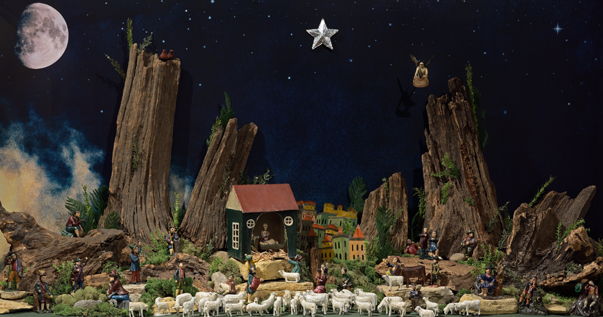The Christmas Stump
From Erzgebirge, Germany, to Wartburg, Tennessee

Status
December 1, 2023 to January 10, 2024Gallery
East Tennessee StreetscapeA Family’s Christmas Tradition
Charles Gottlieb Ficke/Fickey and wife Ernestine Augusta Auerswald, through whom the crèche (above) and Christmas carousel (right) descended, immigrated to the United States from the Saxony region of Germany in 1883. Accompanying them were their sons Ernest, 15, and Theodore, 10.
An anecdotal account has the Fickeys heading to Wartburg (Morgan County), which had been established in 1844 by the East Tennessee Colonization Company for the promotion of land sales in the Cumberland region. The company’s greatest marketing efforts were targeted at the German kingdom of Saxony, where many were seeking to escape poor economic conditions. Most European newcomers arrived in Wartburg between 1846 and 1855, but by 1870, the town had lost its significance as a German-Swiss center. With complaints about the price of land and its lack of productivity, many of the dissatisfied departed for Knoxville, Kingston, Rockwood, or Nashville.
While no official records have as yet been located to confirm the Fickeys presence in Wartburg in 1883, it is known that by his early 30s, Ernest Fickey (1868-1946) was living in Rockwood, where he and his wife, Laura, were parents to eight children. Census information shows him variously as a coal miner and a carpenter.
The legend of this German crèche—called the Christmas Stump by the family—indicates that it had origins in the Fickey’s home district of Erzgebirge some 150 years before being brought to this country. Family members added figures by working on pieces during the winter months, and various wood-working styles are evident. This collection is tied to the Erzgebirge carving tradition, which grew from the decline in silver and tin mining in the Ore Mountains during the 17th century and became an important supplemental income for miners’ families. Around 1930, Ernest was concerned about the long-term preservation of the nativity set and transferred ownership to his physician, Dr. George E. Wilson (1886-1961), also of Rockwood. Immediately cherished by its new owner, the set has descended through his family.

The Christmas Stump Conservation Fund
- The Museum of East Tennessee History received the creche in 2014 as a donation from the family. Unfortunately, this may be the last year to display The Christmas Stump. The creche is made up of over 80 hand-painted wood miniatures that are now over 150 years old. Over time the paint and wood have become more delicate, and handling the objects every year increases the risk of damaging them due to their fragile nature. In order to ensure that we can properly conserve these objects and preserve them for years to come, we must take steps towards their care. We plan to work with a conservator in the region to move forward with a proper cleaning and any repairs that need to be done. Then we will work with a fabricator to build a base for the display with mounts to limit the amount that the curators have to touch the objects.



